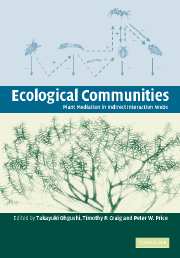Book contents
- Frontmatter
- Contents
- List of contributors
- Preface
- Part I Introduction
- Part II Interaction linkages produced by plant-mediated indirect effects
- 2 Plant-mediated interactions in herbivorous insects: mechanisms, symmetry, and challenging the paradigms of competition past
- 3 Going with the flow: plant vascular systems mediate indirect interactions between plants, insect herbivores, and hemi-parasitic plants
- 4 Plant-mediated effects linking herbivory and pollination
- 5 Trait-mediated indirect interactions, density-mediated indirect interactions, and direct interactions between mammalian and insect herbivores
- 6 Insect–mycorrhizal interactions: patterns, processes, and consequences
- Part III Plant-mediated indirect effects in multitrophic systems
- Part IV Plant-mediated indirect effects on communities and biodiversity
- Part V Evolutionary consequences of plant-mediated indirect effects
- Part VI Synthesis
- Taxonomic index
- Author index
- Subject index
- References
4 - Plant-mediated effects linking herbivory and pollination
Published online by Cambridge University Press: 12 August 2009
- Frontmatter
- Contents
- List of contributors
- Preface
- Part I Introduction
- Part II Interaction linkages produced by plant-mediated indirect effects
- 2 Plant-mediated interactions in herbivorous insects: mechanisms, symmetry, and challenging the paradigms of competition past
- 3 Going with the flow: plant vascular systems mediate indirect interactions between plants, insect herbivores, and hemi-parasitic plants
- 4 Plant-mediated effects linking herbivory and pollination
- 5 Trait-mediated indirect interactions, density-mediated indirect interactions, and direct interactions between mammalian and insect herbivores
- 6 Insect–mycorrhizal interactions: patterns, processes, and consequences
- Part III Plant-mediated indirect effects in multitrophic systems
- Part IV Plant-mediated indirect effects on communities and biodiversity
- Part V Evolutionary consequences of plant-mediated indirect effects
- Part VI Synthesis
- Taxonomic index
- Author index
- Subject index
- References
Summary
Introduction
Over its lifetime, an individual plant must cope with a variety of challenges posed by other species. In fact, it may be interacting simultaneously with competitors, consumers, and a variety of mutualists, including pollinators, seed dispersers, and root symbionts. How the plant will fare in the presence of both beneficial and antagonistic species is at least in part a function of the resources it is able to devote to attracting and deterring them. Since resource availability is not unlimited, this sets up a situation in which allocation in the context of one set of interactions (such as attracting and rewarding mutualists) may force a trade-off with allocation in the context of another (such as defending against antagonists). While these trade-offs are well known, the vast majority of studies of interspecific interactions nevertheless focus on a single kind of interaction at a time. Hence, we know remarkably little about the nature and consequences of interactions among interactions experienced by a single organism.
One notable exception involves the topic of this chapter, interactions between herbivory and pollination. The literature on the ways in which herbivory alters pollination rates and hence reproductive success has grown rapidly in recent years. The large communities of researchers who focus on herbivory and on pollination now clearly recognize that they are not independent (Strauss 1997, Strauss and Armbruster 1997, Adler and Bronstein 2004, Irwin et al. 2004; see also Chapter 7, this volume).
- Type
- Chapter
- Information
- Ecological CommunitiesPlant Mediation in Indirect Interaction Webs, pp. 75 - 103Publisher: Cambridge University PressPrint publication year: 2007
References
- 26
- Cited by

